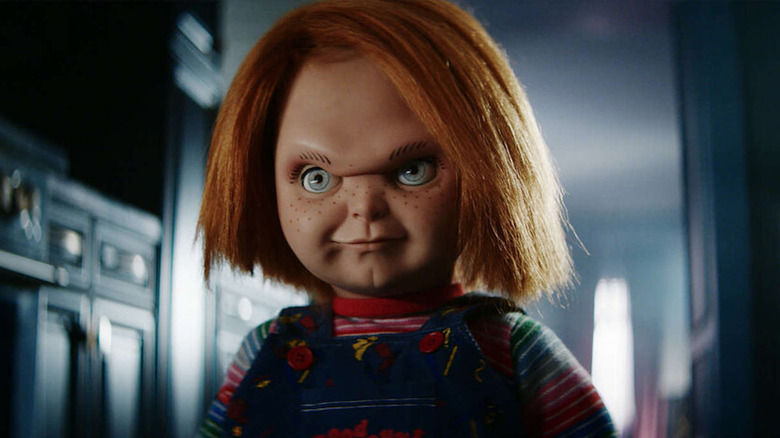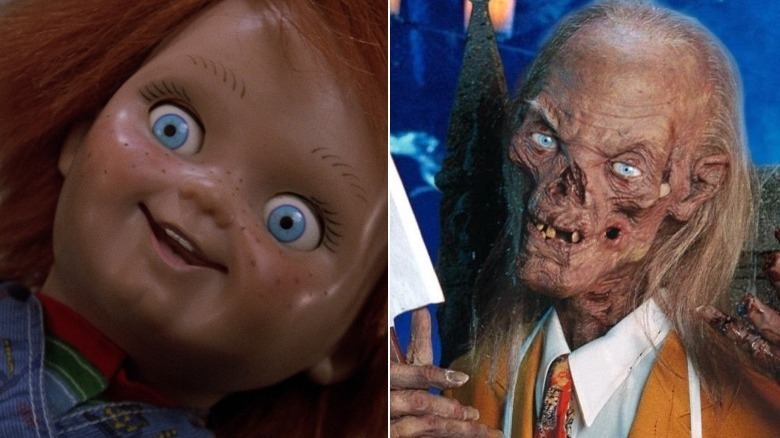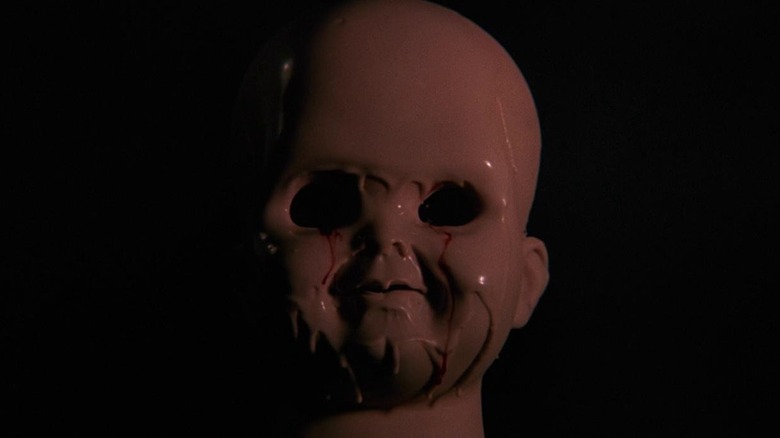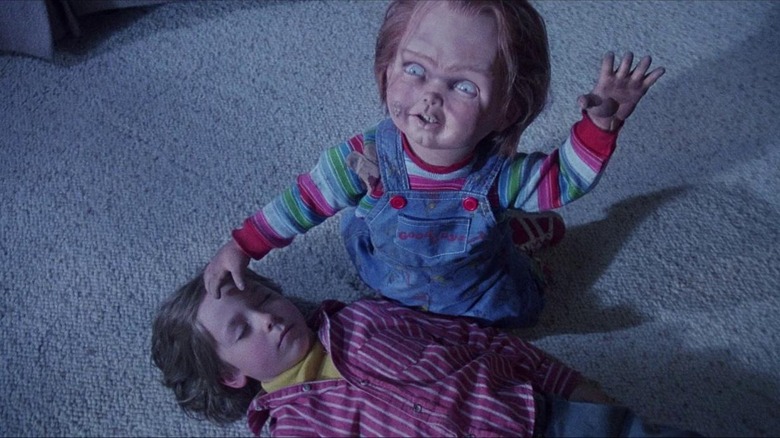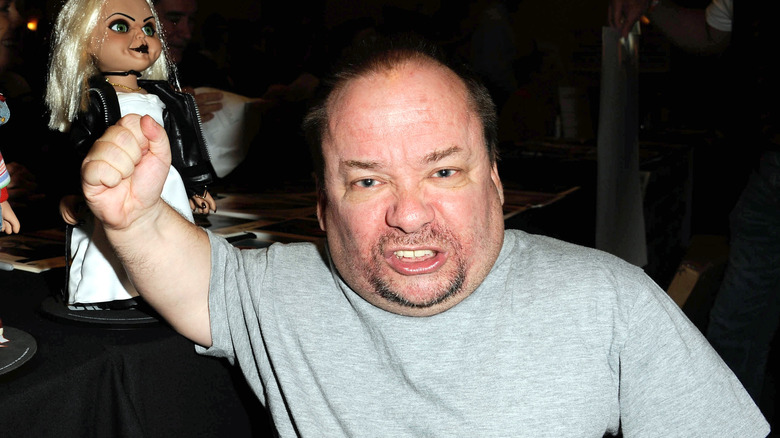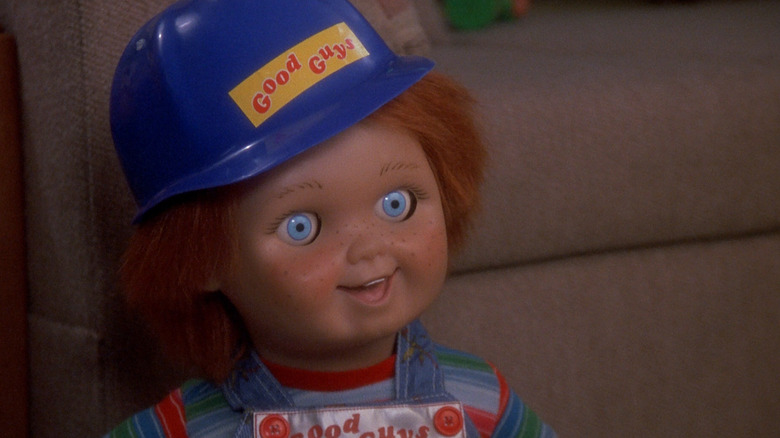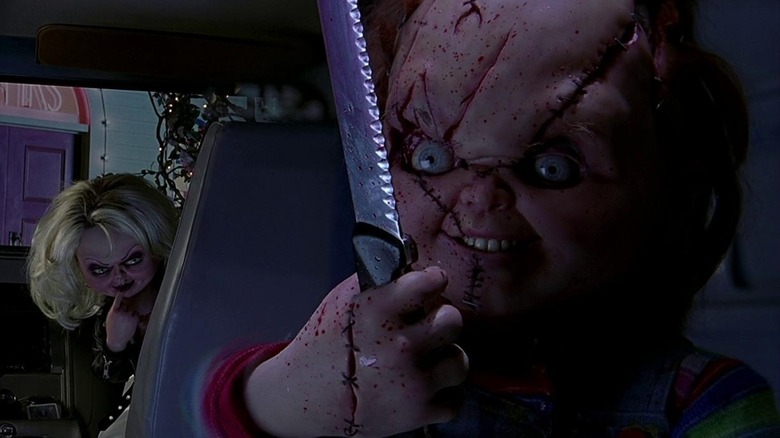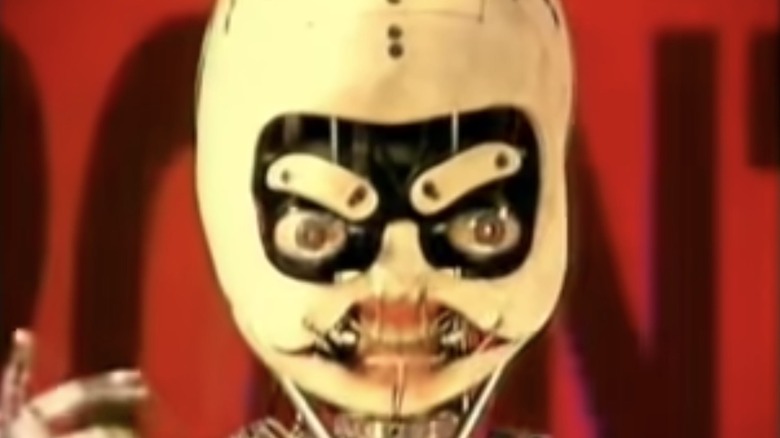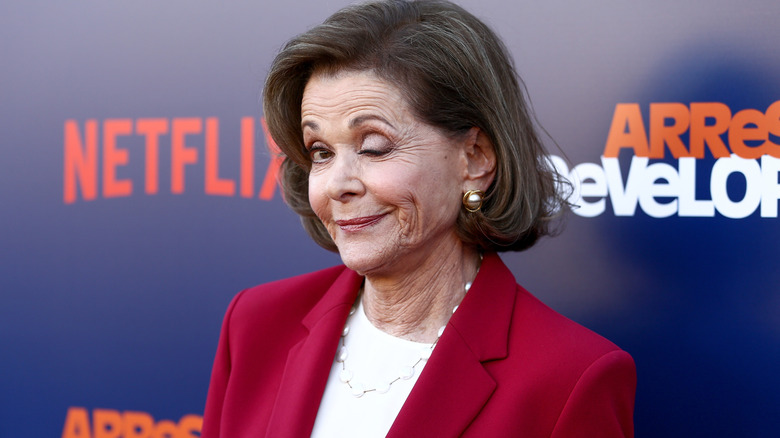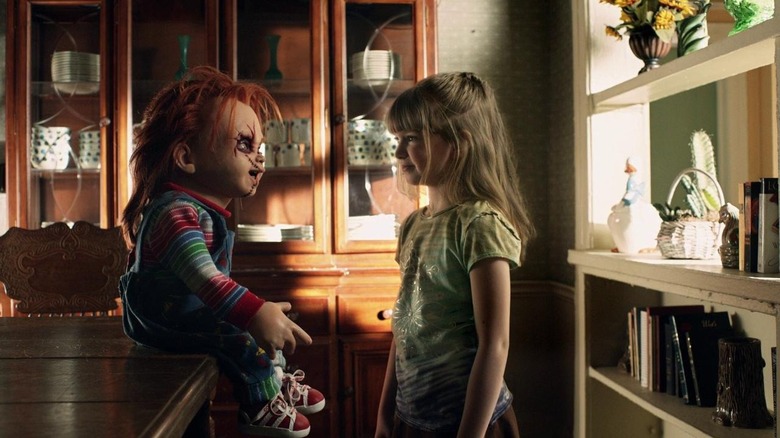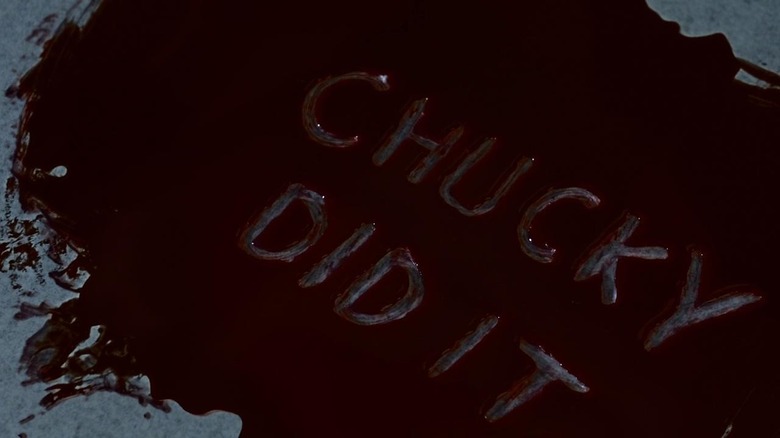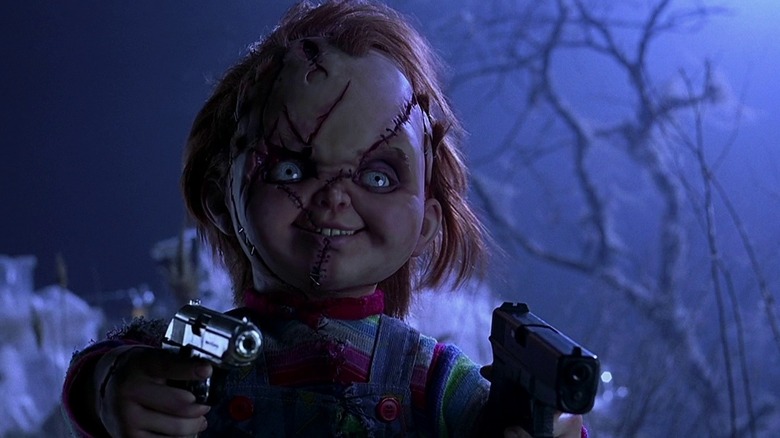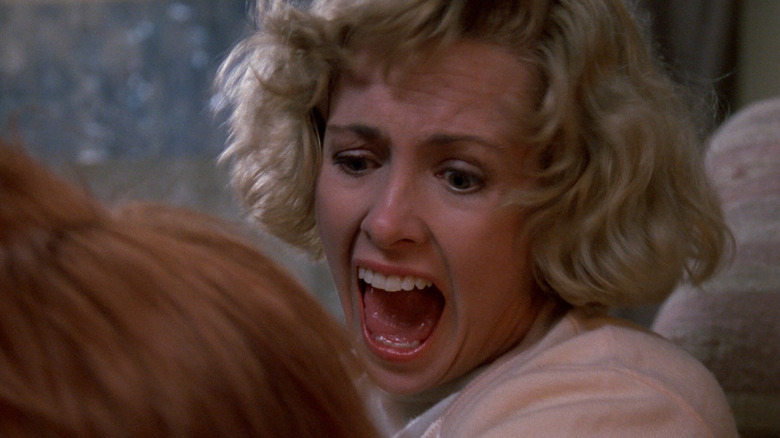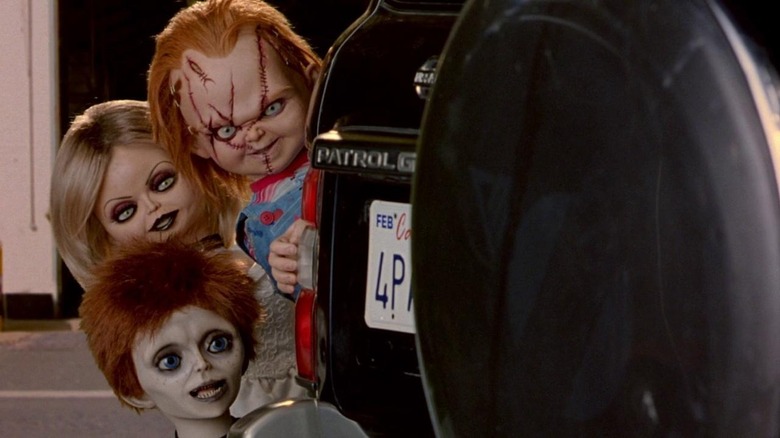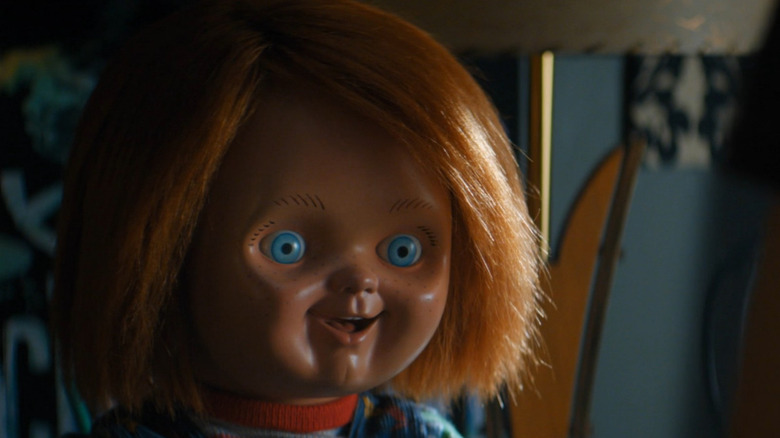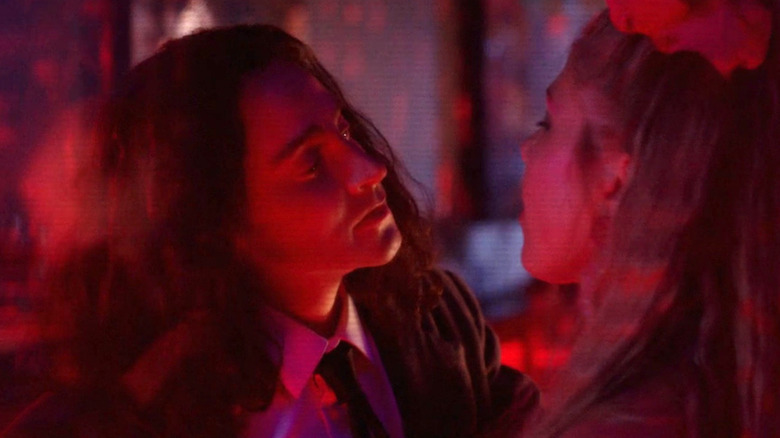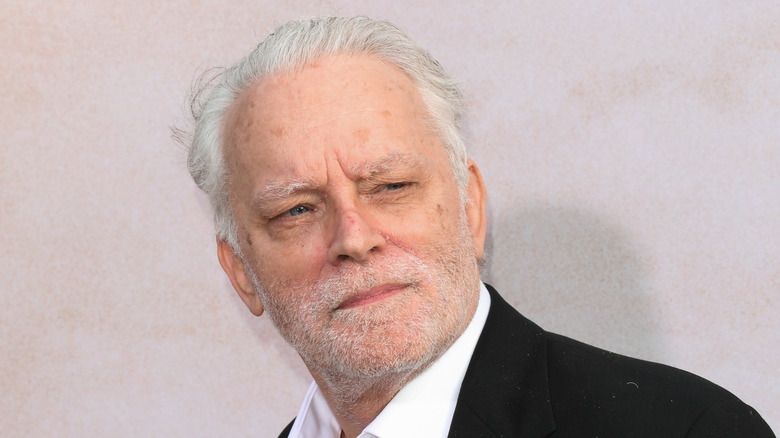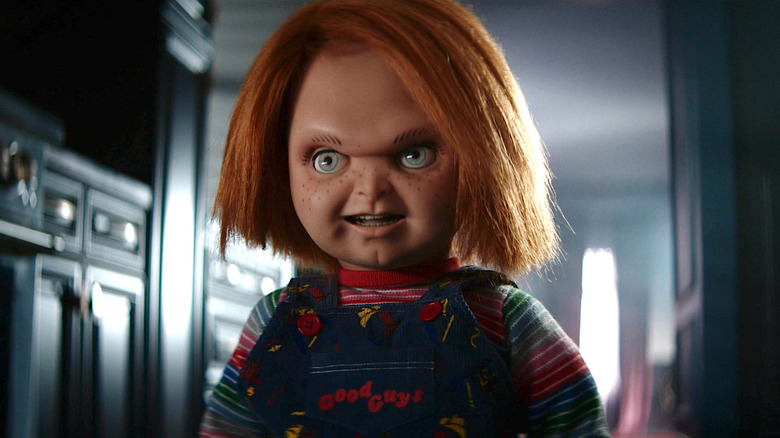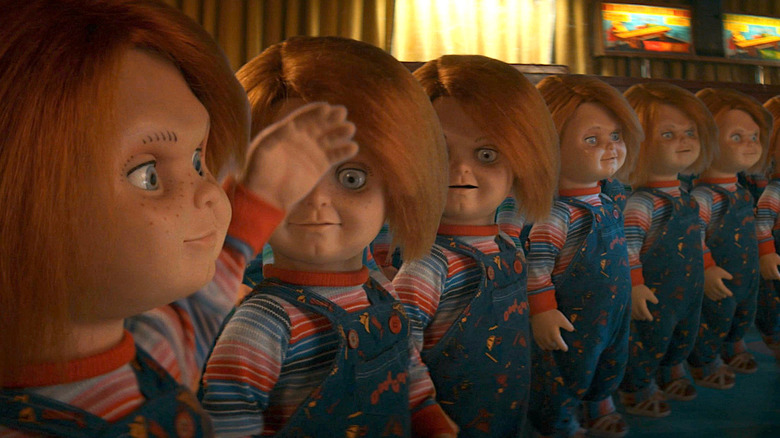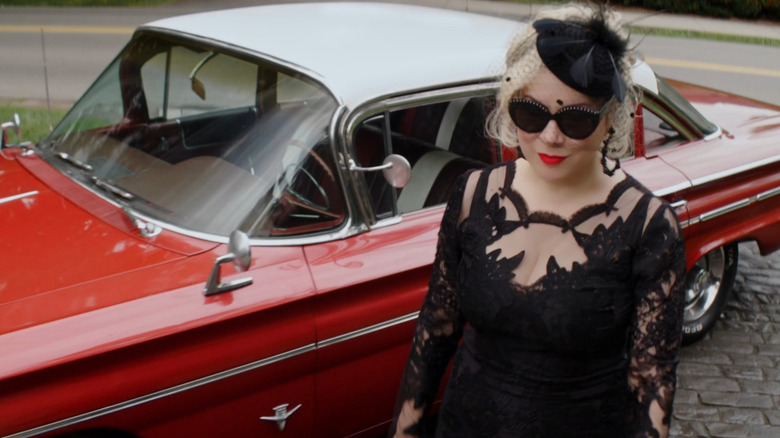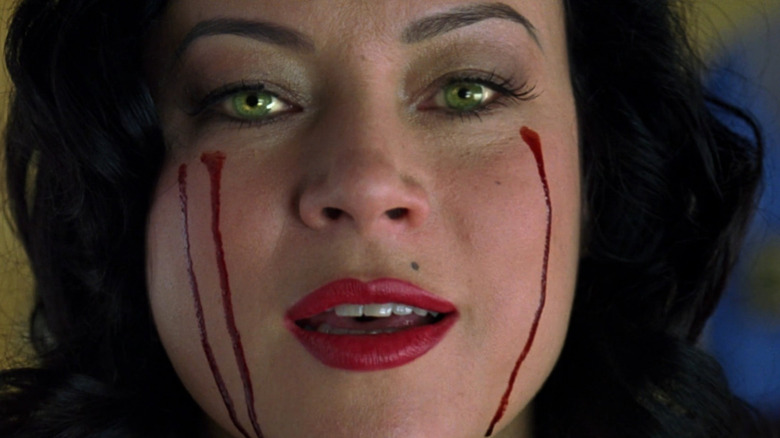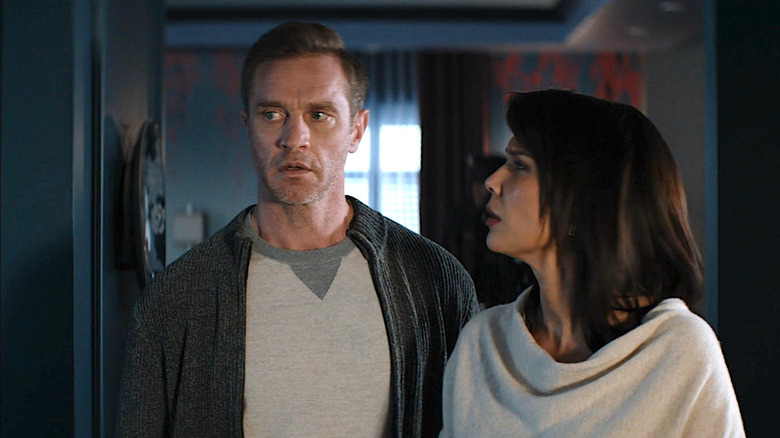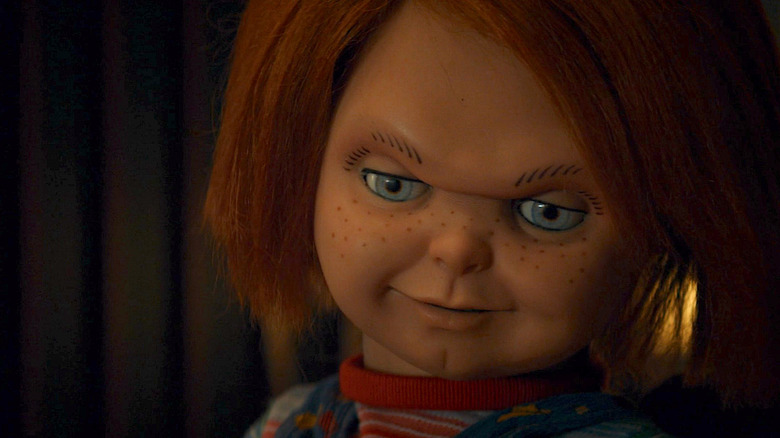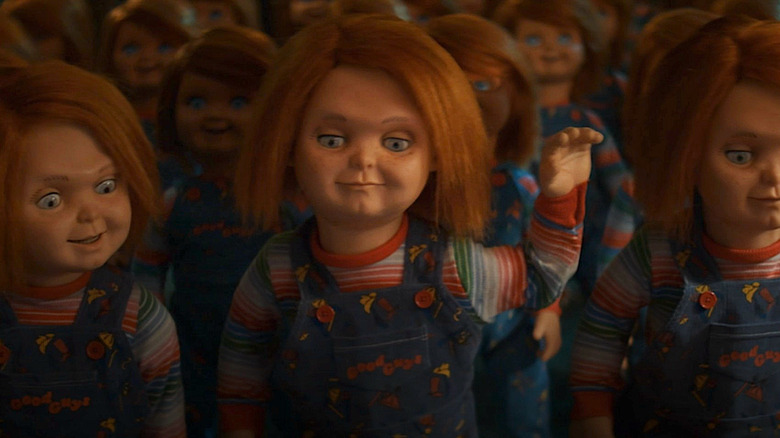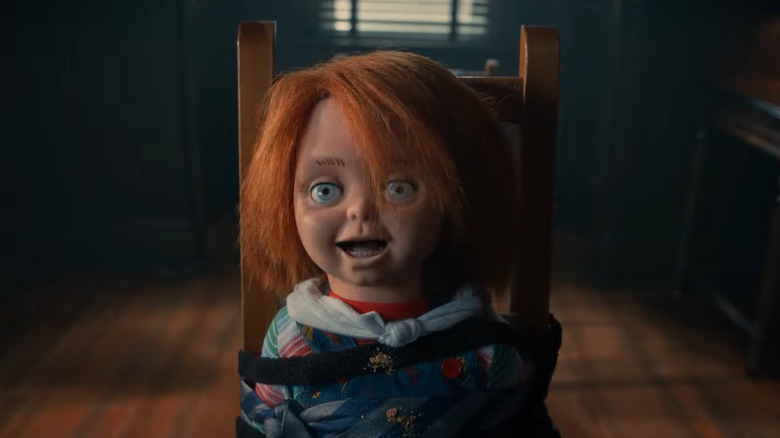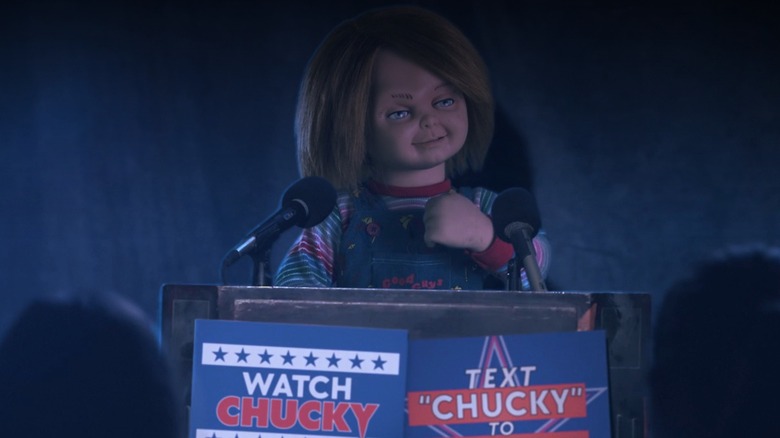The Untold Truth Of Chucky From Child's Play
With seven films, one remake, and a TV series, Chucky truly has been a friend to the end, hasn't he? A heavy-hitter slasher villain, Chucky has been a constant, pint-sized presence in horror for over 30 years (and counting!).
In his debut feature, 1988's "Child's Play," a voodoo-practicing serial killer named Charles Lee Ray (Brad Dourif) transfers his soul into a nearby Good Guy doll before he is gunned down by the fuzz. Tasked with killing the first human he revealed his true self to, Chucky spends the better part of two sequels trying to get his little plastic mitts on Andy Barclay (Alex Vincent). 1998's "Bride of Chucky" marked a significant tonal shift in the franchise towards '90s-friendly meta-humor, as our slash-happy anti-hero reconnected with his ex-girlfriend Tiffany Valentine (Jennifer Tilly), who herself becomes imprisoned in doll-form after an especially, uh, homicidal lover's spat. Chucky "getting lucky" leads us to the next sequel, 2004's "Seed of Chucky," where Tiffany and Chucky's hell spawn resurrects their parents, causing all manner of chaos in the process.
Two video-on-demand sequels followed that brought the franchise back to its more straight-faced horror roots: 2013's "Curse of Chucky" and 2017's "Cult of Chucky." In 2019, a reboot of the original 1988 film asked: What if Chucky was a weaponized Google Home? (Longtime series fans answered: "No, thanks!") With a sizable cinematic legacy and oodles of behind-the-scenes tidbits trailing in his wake, there's plenty to discuss when it comes to Chucky's legacy. So join us for a look into what makes Chucky ... well, Chucky.
Chucky's eyes were re-used in Tales From the Crypt
As far as character design goes, Chucky has been remarkably consistent over his decades-spanning career. Sure, his plastic mug has undergone the wee edit here and there. But overall, the Good Guy's brand is strong: the flaming red hair, the jean overalls, and of course, those icy peepers. Like Charles Lee Ray actor Brad Dourif, the glassy eyes of Good Guy dolls are a piercing blue. So while Chucky takes on increasingly more human traits as he inhabits his doll body (including bushier eyebrows and a widow's peak), the iconic eye color is a perfect match.
Chucky's ice-blue eyes, along with the rest of him, were designed by creature effects artist Kevin Yagher (who worked on the first three "Child's Play" films). If you're a prolific horror hound, you might be thinking to yourself, "Gosh, I feel like I've seen those eyes before." Well, you have. One of Yagher's other creations includes the ghoulish, pun-loving host of HBO's anthology series "Tales from the Crypt." Indeed, lodged inside the Crypt Keeper's sunken, sinewy skull you'll see a pair of expressive blue eyes that once belonged to a certain Good Guy.
Chucky was inspired by a whole bunch of evil talking dolls
The list of spooky predecessors who inspired Chucky is nothing to scoff at, and his creators are more than eager to cite their sources. One of the inspirations for the Good Guy dolls was an interactive talking doll named "Corky" (whose voice actor, Edan Gross, provided the Good Guy "friendly" voice). There are striking similarities between the Good Guy design and Hasbro's My Buddy doll, as well as the iconic, pudgy-cheek'd Cabbage Patch Kids. The creators also drew inspiration from notable killer dolls of the horror genre, including the Telly Savalas-hating Talky Tina from the "Twilight Zone" series and the notorious Zuni warrior doll from 1975's traumatizing "Amelia" segment of "Trilogy of Terror."
While not a direct inspiration, it's hard to not consider Chucky's real-life counterpart. Enter: Robert the Doll. Dressed as a sailor and standing at 40 inches tall, Robert (named after his young owner Robert Eugene Otto) was supposedly infused with black magic and voodoo by a disgruntled family maid. The (rumored) laundry list of creepy occurrences includes the doll wandering around in the middle of the night, rearranging furniture, and terrorizing family pets. Childish storytelling? Or something more supernatural? Either way: Robert and Chucky are kindred, nefarious-doll spirits.
It took a lot of people to puppeteer Chucky ...
It sounds like some kind of macabre joke set-up: How many special effects technicians do you need to operate the puppet of a deranged killer doll possessed by the soul of a serial killer? The answer, at least when it came to the original 1988 film, is just under a dozen. "It took like 11 people to make the puppet work," executive producer David Kirschner told Mental Floss in 2019. The puppet featured in about half of the film was radio-controlled, employing animatronic techniques considered ground-breaking at the time. Director Tom Holland tapped 3-foot, 6-inch performer Ed Gale for broader, less subtle, movements.
"Facially, nothing can beat a puppet," recalled Gale in the same Mental Floss retrospective. "But to make it actually work full-body, running, or jumping, they needed me." Overseen by Kevin Yagher, the designer and executor of the psychopathic doll, one of Chucky's puppeteers was the late, great N. Brock Winkless IV (of "Tales from the Crypt" and "Terminator 2: Judgement Day" fame).
The presence of puppeteers and practical character effects work more broadly has become an expectation in the series. While CGI has made its way into the "Child's Play" franchise over the years, on-set puppets are and will hopefully remain a must.
... But sometimes body doubles were required
If only Chucky could simply be brought to life by voodoo magic. But (fortunately for special effects lovers) the reality is much more labor-intensive, involving puppeteers, animatronics, a sprinkling of CGI, and yes, body doubles.
Over the course of the series, when action-packed wide shots are required, Chucky has been portrayed by short-statured actors and children. The most prolific performer, far and away, is Ed Gale, who stands at around 3 feet and 6 inches tall and made his film debut as the title character in 1986's "Howard the Duck." In addition to the original "Child's Play," Gale played Chucky in "Child's Play 2" and "Bride of Chucky."
"The puppet would move more smoothly, and I'd walk a little more like a robot. We'd meet in the middle," Gale told Mental Floss. "The problem was that I had zero visibility. I'd rehearse and walk through a scene with my eyes closed. It's like taking a drink while blindfolded. You look like an idiot. I was also set on fire." In addition to Gale, one other notable Chucky stunt double in the original film was Alex Vincent's kid sister Ashley, who you can spot sprinting around the apartment terrorizing Maggie the babysitter.
Chucky has a theme song, and it's a bop
Horror fans are suckers for a film that comes with a song recounting the plot of said film. Among the best of these is The Fat Boys' "Are You Ready for Freddy?" from 1988's "A Nightmare on Elm Street 4: The Dream Master," the chaotic musical masterpiece that concludes the under-seen Stephen King adaptation "Graveyard Shift," the "Shocker" song from 1989's "Shocker," or The Ramones singing about how they didn't want to be buried in a "Pet Sematary."
If you're vibing with all of this: great news. There is a lost "Child's Play" theme song and it's incredible. Created by "Child's Play" composer Joe Renzetti and singer and songwriter Simon Stokes, the theme song went unused for some reason. Originally intended to play under the closing credits of the film, it was cut at the last minute and replaced with a less, uh, cheesy track. With lines like "You know, pals are hard to come by/ But you'll find that I'm a Good Guy," schoolyard chants, and one hell of a bass line, "The Chucky Song" is bananas, catchy, and will hopefully be revived for some sequel down the line.
The origins of Chucky's human name
Ever notice how killers and assassins tend to be publicly referenced by three names? John Wayne Gacy? John Wilkes Booth? Mark David Chapman? Perhaps it's society's way of attempting to decrease the odds of awkward situations for folks who happen to share the same name. Fittingly, the full government name of the murderous "Child's Play" franchise villain follows a similar triptych format: Charles Lee Ray. That just sounds right, doesn't it?
Abbreviated to the less wordy (but no less sinister) "Chucky" once in doll form, Charles Lee Ray's human name comes from three different prolific killers: cult leader Charles Manson; John F. Kennedy's killer Lee Harvey Oswald; and Martin Luther King Jr.'s assassin, James Earl Ray. A nasty moniker cobbled together from the names of three notoriously nasty men, Charles Lee Ray sounds evil for good reason.
Chucky makes a cameo in a Daft Punk music video
For some reason, the union of Chucky and the French, robot-headed techno duo Daft Punk feels like a match made in heaven. Or looking at the above image, maybe hell.
Yes, if you're a Daft Punk fan, there's a good chance you've seen under Chucky's skin without even realizing it. The video for "Technologic," the second single off the duo's third studio album "Human After All," has Thomas Bangalter's pitch-altered voice chanting technocratic phrases that seem to originate from a malicious televised doll with exposed circuitry and false teeth. As the wire-clad freak barks orders ("plug it, play it, burn it, rip it") a seemingly more naive skinless robot doll looks on in awe, flanked by the robot duo. Or maybe it is the same doll, super jazzed about the techno propaganda he's created.
Given that the music video for "Technologic" came out in 2005, just one year after the release of "Seed of Chucky," it seems likely that this particular, skinless monster was created by Tony Gardner and the crew over at Alterian Inc. Gardner worked on both projects, as well as "The Prime of Your Life" and "Daft Punk's Electroma."
The original voice of Chucky was Jessica Walter
Everybody loves Brad Dourif's raspy, profanity-filled vocal performance as Chucky. But while hindsight is 20/20, Dourif providing the stab-happy toy's voice wasn't always part of the plan.
The "One Flew Over the Cuckoo's Nest" Oscar nominee was indeed cast to play Charles Lee Ray in the original film. But originally, actress Jessica Walter (later of "Arrested Development" fame) was going to voice the killer doll. The involvement of Walter (who passed away in 2020) was mentioned on the "Child's Play" commentary track. According to director Tom Holland (via Mental Floss), "[Walter] could make the threats work, but not the humor. So we went back to Brad." Longtime series writer Don Mancini said the attempt at female casting was due to one of the most successful horror films of all time. "Tom's logic," he says on the track, "was that the voice of the devil was done by a woman in 'The Exorcist.'"
Real-life murders have been blamed on Chucky
People love a clear, simple explanation, so you can't blame some for seeing a straight line between violent horror films and copycat crimes.
The debate over whether on-screen violence inspires real-life violence is an old one. As legendary genre director John Carpenter put it at a 2007 Tribeca Film Festival panel: "Real-life causes [violent acts], fake life does not. ... Censorship never works. ... You can hide, you can try to cover it up, but you can't destroy it." A 2009 study seemed to suggest that horror movies may actually help stop violent crimes (via The Washington Post), but while science seems to suggest that horror movies do not cause aggression, there are still people in the world who will take life imitating art to disturbing lows.
"Child's Play 3" was cited as the "inspiration" for two murders in the United Kingdom, those of Suzanne Capper and James Bulger. In response to both tragedies, "Child's Play" director Tom Holland told the Independent in 1993 that people who watch horror and are inspired to commit crimes are "unbalanced to begin with."
Chucky's origin was originally blood magic
In the original 1988 film, Charles Lee Ray uses a voodoo prayer to the sky god Damballa to transfer his soul into the plastic prison of a nearby Good Guy doll. Over the course of the series, other practitioners like Tiffany and Glen employ the chant for similar purposes to aid Chucky in his hellish quest to cheat death.
But Chucky's abuse of voodoo magic wasn't always part of the plan. As writer Don Mancini explained in a 2019 oral history from Mental Floss, at one point, the script was titled "Blood Buddy." Per Mancini, in the older version of the script, the doll was not possessed by the voodoo-transferred soul of a serial killer but was rather "a manifestation of a little boy's unconscious rage."
To explain how the doll "came to life," Mancini devised an especially gruesome scenario. "If you played too rough with [the doll], his latex skin would break and he'd bleed this red substance so you'd have to buy special bandages," explains Mancini. "So the boy, Andy, in a rite of brotherhood, cuts his thumb and mixes it with the doll's blood, and that's the catalyst that brings the doll to life." The idea was ultimately nixed. As executive producer (and, at the time, new father) David Kirschner puts it: "[He] wasn't sure anybody would buy a doll with blood in it."
Chucky boasts an impressive kill count
Okay, sure, people dying is "bad." And keeping score of how many people die in horror movies is silly, if not mildly disturbing. But hey, that's what slasher movies are all about.
Should you wince, or root on these killers? At the end of the day, it depends on the film, the franchise, and the kill. With eight films, including a reboot, Chucky holds his own with the best (or is that the worst?) of his slasher peers. So compared to the likes of Freddy Krueger and Leatherface, how does little Chucky stack up, kill-wise?
If this tally from ScreenRant is to be believed, Chucky is doing pretty well for himself, coming in at fourth place with a total of 67 confirmed kills. Putting him among a killing class of Jigsaw, Michael Myers, and Jason Voorhees, Chucky is clearly head and shoulders above many of his peers — even if, quite literally, he is not. So step up your game Pinhead; you're an inter-dimensional Hell Priest and you're losing to a ticked-off serial killer trapped in a 2-foot-tall doll body.
Andy's mom is the real bride of Chucky
Yeah, you all know about "Bride of Chucky," the fourth "Child's Play" film released in 1998 where Chucky infamously "gets lucky." But did you know that there is another, real, "bride of Chucky?" In the original 1988 film, Catherine Hicks plays Karen Barclay, mother of Andy, and the film's de facto final girl. On the set, she met Kevin Yagher, special effects make-up artist and creator of the "Chucky" doll. They promptly hit it off.
In a 2020 interview with ABC7, Yagher recalled meeting her on the set. He had been scheduled to do her make-up, but when it came time she nixed the idea, secretly afraid of letting a cute guy see her skin up so close. "She didn't want me to see any flaws, so she nixed the idea."
The pair were married in May of 1990, and are still going strong after more than 30 years. They have a daughter named Caitlin, and it's safe to say that no one can beat them when it comes time to tell "we found love in the strangest place" stories.
Chucky has become a queer icon
Chucky was never "gay" by design. But as a franchise, things took a campy, queer-coded turn with the 1998 sequel "Bride of Chucky." For that, we have openly gay Chucky creator Don Mancini to thank. Any subtle queer vibes in "Bride" (including the presence of lesbian fave and "Bound" star Jennifer Tilly) were brought to the forefront in its follow-up "Seed of Chucky." That film saw Chucky fathering a non-binary child named Glen/Glenda, a nod to queer pioneer Ed Wood's film "Glen or Glenda."
"There are always positive gay characters in the "Chucky movies," recalled Tilly in 2017. "Universal said, ['Seed of Chucky' is] too funny, it's too gay. ... Don just basically had a carnival of fun with that movie."
While the subsequent two sequels in the franchise, "Curse of Chucky" and "Cult of Chucky," played things more "straight," the franchise returned to a gender-fluid space when Nica (played by Brad Dourif's real-life daughter Fiona Dourif) was possessed by the soul of Charles Lee Ray. At the conclusion of "Cult," Nica (possessed by Chucky) kisses human-form Tiffany (Tilly) before driving off into a snow-filled, nonexistent sunset. "This is different," says Chucky. "I don't know," Tiffany replies. "It works for me."
Chucky heads to the small screen for the first time
While Chucky is certainly no stranger to the big screen — or the odd small screen cameo here and there — for the first time in his decades-spanning career the gruesome Good Guy got his own TV series in October 2021.
"Chucky" follows the continuity of the "Child's Play" movies overseen by longtime series writer Don Mancini and features old favorites including Brad Dourif, Jennifer Tilly, Fiona Dourif, Alex Vincent, and Christine Elise McCarthy. Speaking with SYFY WIRE in 2020, Mancini explained that the show was more serious and more tonally in line with the first two films. The series is set in a sleepy small town and revolves around teenage artist Jake (Zackary Arthur). After Jake unwittingly purchases the possessed doll at a yard sale, the murders are quick to follow.
The series has been well-received so far, with critics giving it an average of 91% on Rotten Tomatoes.
Brad Dourif and daughter Fiona play young Chucky
Father-daughter acting duo Brad and Fiona Dourif have appeared onscreen in the Chucky-verse before — but the "Chucky" TV series puts an all-new twist on the dynamic duo. Fiona Dourif first appeared in the "Child's Play" franchise as the terminally unlucky Nica Pierce. Nica was the final girl in 2013's "Curse of Chucky" and the final girl possessed by Chucky in 2017's "Cult of Chucky." Keeping up so far?
Chucky is still living rent-free in Nica's mind in the "Chucky" TV show, and watching Fiona play Nica and the Chucky-possessed Nica is a treat to behold. But there's a scene with Fiona in a Season 1 flashback — showing Charles Lee Ray meeting Tiffany — that is truly mind-blowing.
Fiona, who looks a lot like Brad anyway, is styled to look exactly like he did when he first portrayed Charles Lee Ray in the original "Child's Play." Brad then dubbed his daughter's dialogue for the scene, and the result is demented and delightful. "It's like an Instagram face mash app, except you can't get it off," Fiona told Bloody Disgusting. "I face-timed my dad, as my dad ... it was really weird. That's all I got. It's weird." But hey, if we know anything about the world of "Child's Play" by now, it is that it could always get weirder.
Dourif was still challenged by the Chucky series
Brad Dourif has played Chucky since the very beginning, but that doesn't mean that voicing the devilish doll doesn't still present him with a challenge — pretty impressive really after three decades (and counting) doing this job.
"I know the character really well, so I feel like I should be able to just go in there and do it. But Don always comes up with some s*** that makes it harder," Dourif joked in a SYFY virtual Television Critics Association panel. Dourif went on to explain the multiple Chucky dolls in "Chucky" Season 2, as well as Mancini's constant reinventions for his role kept him on his toes.
"I gotta tell you, I was really scared at times that I was gonna f*** this up big time," he told SYFY WIRE. "But that's all good. Being challenged is a good thing, especially for someone who kind of considers himself to be retired."
Is Chucky an ally or a bully?
Why can't a killer doll be both? Horror impresario Don Mancini set out to expand Chucky's audience to young adults with the "Chucky" TV series. Part of that is by lacing a sweet, gay love story between two teens into the heart of the show — and part is by showing how the bullied ultimately triumph over their bullies. Either through disgusting doll-assisted murder or, you know — friendship and self-acceptance.
"The culture of bullying that exists in recent years among today's youth is in itself a true life horror story," Mancini told Den of Geek. "We use Chucky as a metaphor, as the ultimate bully. He is charming and he's funny. Bullies can appear to us in that guise and be seductive." Throughout the course of the "Chucky" series, Chucky tries to get kids who feel oppressed some relief — by letting them help him kill their oppressors. It works out in Chucky's bloody favor about half the time, but the real triumph comes from watching the teens — like Jake — resist Chucky's lure to the dark side.
"When Chucky ends up in a kind of weird, toxic, bullying relationship with [Jake in the series], one of the ways he's able to manipulate this kid is by ironically expressing a kind of empathy and sympathy for him," Mancini told Advocate. Chucky might not exactly be a true ally, but, Mancini says, "He's not homophobic, and he's not a bigot. He's an equal opportunity killer." And that's progress.
Chucky's horde is not a hive mind
The ins and outs of Chucky's seemingly immortal soul can get a little confusing — especially when our heroes are faced with multiple Chuckys. Whether slivers of Charles Lee Ray's soul are showing up in Good Guy dolls, left-alive victims, or an entire army of them in the "Chucky" TV series, the mythology behind them isn't always clear — aside from the fact that Chucky's self-horcruxing ability would make Voldemort weep with jealousy.
Chucky creator Don Mancini did clarify, however, that Chucky's manifestations are distinct and not one entity. Mancini told Bloody Disgusting that an army of Chuckys always appealed to him, but he said, "It's definitely not a hive mind." He went on to explain that he considered the hive mind option but ultimately decided on the idea of different Chucky personas.
Buff Chucky, Good Chucky, Chucky Prime — they're all different sides of the same killer coin. Mancini says a large part of this was to showcase Brad Dourif's different performances, so the show could focus on "dissecting the persona of Chucky and the persona of Charles Lee Ray." Dissecting sounds right up every Chucky's alley — well, except for Good Chucky.
Chucky pulled Jennifer Tilly out of retirement
Chucky is a killer doll who refuses to die — and one that keeps plenty of character actors' careers alive. Jennifer Tilly, the "Bride of Chucky" herself, expected her role in the "Chucky" TV series to be a cameo. But Mancini wrote her a deep and layered character that restarted her acting career. Essentially, "Chucky" pulled Tilly out of retirement like Jake pulled Chucky out of a yard sale in "Chucky" Season 1.
Tilly plays Tiffany Valentine (and Jennifer Tilly) in the "Chucky" series, and the show even dramatizes the bloody first meeting between Tiffany and her bad beau, Charles Lee Ray. Tiffany's journey through death and destruction (and maybe even better romantic choices) is one the real Tilly is thankful for.
"Sometimes, you get put in a box when you're an older actress," she told Bloody Disgusting. "I don't know what parts there are for all the women because I never get offered them." She expresses Mancini's ability to write such an interesting part for her in the "Chucky" series, going on to say, "She's just this really campy character that's a killer but has a very good fashion sense. I liked that he gave her some really dramatic scenes this season and last, and you can dig your teeth into her."
One episode has all its knives out
Chucky is constantly reinventing himself. From hardcore slasher in the original "Child's Play" to gothic romance in "Bride of Chucky" and all the horror-comedy hijinks of "Cult of Chucky" and "Seed of Chucky," creator Don Mancini is clearly not afraid to try something new, whether it's with his iconic killer doll character or the franchise as a whole. So it's both a total surprise and no surprise at all that one episode of the "Chucky" TV series acts as a standalone Agatha Christie-style murder mystery.
"Death on Denial" is Chucky's standalone whodunit. It takes place in Season 2, Episode 4 of the "Chucky" series, and comes complete with multiple celebrity guest stars who all point the finger — and possibly the butcher knife. The guest cast includes Jennifer Tilly's cult classic film "Bound" co-stars Gina Gershon and Joe Pantoliano. The episode also stars Tilly's real-life sister, Meg Tilly.
"Jennifer was, not surprisingly, extremely instrumental in helping put all of that together," Mancini told Entertainment Weekly. "To be able to reunite that cast and work with them is kind of a queer fever dream come true, honestly." While Chucky doesn't make a huge appearance in this very different murder mystery episode, he has the same impact as a butcher knife-wielding Benoit Blanc from "Knives Out."
A '90s horror heartthrob plays multiple roles in the TV series
... And Chucky hates them all. Devon Sawa, former '90s teen dream and current 40-something-year-old hunk, has played multiple roles in the "Chucky" series across the seasons. But before he added "Chucky" to his horror repertoire, Sawa was also the star of 1999's "Idle Hands" and 2000's "Final Destination" as well as some more modern (and underrated) horror movies like 2020's "Hunter Hunter."
In Season 1 of the "Chucky" TV series, Sawa plays Jake's angry, abusive father, Lucas Wheeler — as well as his angry, differently abusive uncle, Logan Wheeler. Chucky uses Lucas's bad treatment of Jake to try and bring out some homicidal tendencies in the kid — and has slightly more success elsewhere in Jake's family.
Sawa returns for Season 2 of "Chucky" as Father Bryce, a priest whom Chucky manages to get quite close to in the end. "This new guy is less toxic than the first two guys. But he still has some stuff going on," Sawa told ET Online. Sawa is also set to return for Season 3 of "Chucky" in a whole new house for Chucky to haunt — the White House. Sawa can be seen as the President of the United States in the Season 3 teaser. We sure hope he keeps the nuclear launch codes on the highest shelf in the Oval Office.
Chucky makes the most of his swear limit
Even if Chucky has made the move to TV, he certainly isn't ready for primetime. The devilish doll has a filthy vocabulary — and Don Mancini wouldn't have it any other way.
Mancini credits another movie-to-TV franchise he worked on, "Hannibal," for inspiring Chucky's scurry to the small screen — as well as helping keep the show true to its rated-R roots. "Before we even sold the show, we had to confirm with the network that Chucky could drop his F-bombs," Mancini explained to Entertainment Weekly.
Mancini reported that Chucky gets a maximum of 10 "F-bombs" per episode, which is in stark contrast to what Steven Spielberg got for Chucky when he made a guest appearance in "Ready Player One." "Since that was a PG-13, they had one mandated F-bomb at their disposal and Spielberg chose to deploy it with Chucky's appearance, which I loved," Mancini told Entertainment Weekly.
Season 1 shares the truth behind Chucky's voodoo curse
Chucky is an improvisational killer doll. He goes with the flow and uses what resources he has available to him — just like his human counterpart, Charles Lee Ray, did before him. Does Chucky's on-the-fly nature contribute to the "Child's Play" franchise being riddled with certain plot holes and inconsistencies? Sure. But at least those plot holes and inconsistencies are fun, bloody, and bound to give you a migraine when the sequel series tries to explain them, decades later.
Season 1 of the "Chucky" TV series does its best to clear up why Chucky can seemingly only transfer his soul into Good Guy Dolls. The entire franchise has played with the idea of Chucky drawing on the powers of voodoo and other ill-defined magic to move his rotten soul around like day traders move money. It's also toyed with the idea that Chucky is powered by rage and sacrifice. Really, who isn't?
But the season finale of Season 1 explains that, since Charles Lee Ray used a certain spell in the original "Child's Play" to transfer his soul into a Good Guy Doll, any time he uses the same spell after, he must use an "identical" garbage pail, so to speak, to house his soul. Does this explain why he can sometimes splinter himself up into certain human bodies? No? Maybe they'll explain that in another season finale down the line — or leave it a happy and hilarious mystery.
Good Chucky
Chucky is a relentless, remorseless killing machine. Even when he was in human form, he was depraved and destructive. So could there have truly ever been a time when Chucky was good? The answer is kinda, sorta yeah — and it happens in Season 2 of the "Chucky" TV series.
Jake and the gang capture Chucky and try to brainwash his violent tendencies out of him. It's very reminiscent of a similar scene in that other incorrigible evil classic, "A Clockwork Orange." In the Chucky version, the process works — for a little while.
"Good Chucky" is sweet, innocent, and so disgusted by violence, it makes him puke. The result is so good, it even scares the teens. "We didn't brainwash him. We brain-bleached him," Lexy says. It's a take on the role Brad Dourif apparently loves — even if Good Chucky was destined to break bad again. Still, it might not be curtains for Good Chucky, even after all that transpires in Season 2. "I don't know that we've necessarily seen the last of him just because I think I may need to see more of that," Mancini said in an interview with the USA Network. "Just cause I enjoy it, you know? And I know Brad enjoys it."
Chucky hosted his own press conference for Season 3
Chucky's press conference is as vulgar as one might expect. Chucky takes the too-tall podium to address a very curious press corps in a promotional clip for "Chucky" Season 3. The latest season of Chucky is set in Washington, D.C., and stars Devon Sawa as the President of the United States — even though Chucky refuses to acknowledge he even knows who the actor is. "Devon who?"
Chucky can't stop slinging sass and profanity at the reporters gathered at his SYFY press conference. He's understandably grumpy — the announcement is cutting into his precious terrorizing time. Chucky is clearly upping the ante in his fight against Jake Wheeler and friends (and America in general) by moving headquarters to the Capitol, but he refuses to answer almost any of the questions asked of him by the press.
For a killer doll who seems to crave attention, he could really stand to brush up on his PR skills. Perhaps the events of "Chucky" Season 3 will show Chucky assembling a communications team of his own. Maybe he could even learn how to create a little dance content from M3GAN. Over the years, quite a few things have proven to be true about Chucky, no matter what movie or season he's in: He's always down to learn something — and kill someone — new.
